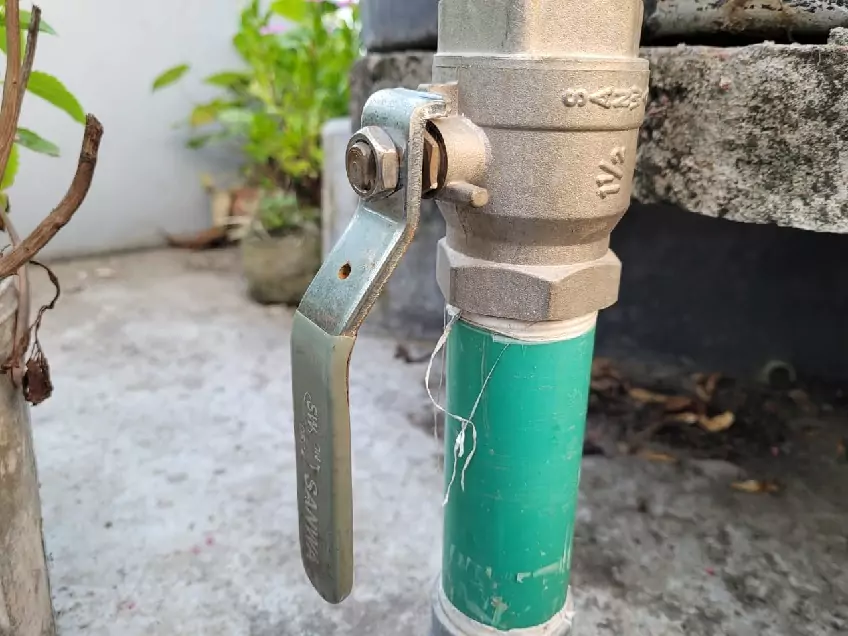Why would an outside faucet not have a shut-off valve? The absence of a shut-off valve is often a result of the faucet design or the age of the plumbing. Normally, faucets are designed to control backflow and may not come with a dedicated shut-off valve, particularly in older homes.
By continuing to read, you’ll learn the implications of not having a shut-off valve, alternative methods to control the water flow, and tips to protect your pipes under diverse conditions.
Where is the Water Shut Off Valve for Outside Faucet
The picture shown below is captured from my uncle’s house near the water meter.

There are several common places to look when you need to locate the shut-off valve for your outside faucet.
- Main Shut Off Valve: Start by inspecting the main shut-off valve for your home. This is typically found in the basement, garage, or near the utility area. This valve controls water flow to the entire house, including outside faucets.
- Interior Access: For homes without a basement, you might find a shut-off valve inside a cabinet near where the outside faucet is located on the other side of the wall.
- Near the Water Meter: Another potential location is near your water meter. The water meter can often be found along the front of your property line or in the basement. There might be a dedicated shut-off valve for the outdoor faucet in this area.
Risks of Not Having a Shut Off Valve
Outdoor spigots without a shut off valve present notable risks. Being aware of these risks can help you mitigate potential damage to your property.
Water Leakage
Detecting and Responding: If there’s no shut-off valve, keeping an eye out for leaks becomes more challenging. Without one, you might not realize a leak has happened until a lot of water has been wasted or damage has occurred. It’s harder to respond quickly to leaks because you can’t easily stop the water supply without shutting down the main valve.
Possible Damage: Persistent water leakage can cause lasting structural damage, like weakened foundations and water seepage. It can also promote the growth of mold and mildew, impacting your home’s air quality and your well-being.
Freezing Risks
When it gets really cold, water in outdoor spigots can freeze and make the pipes burst. If there’s no shut-off valve, water stays in the pipes and makes them more likely to freeze and burst.
Fixing a burst pipe from freezing is not just a hassle but can also cost a lot. You might need to replace parts of the pipe and fix any water damage it caused. This not only means paying for plumbing but also for structural repairs if it’s a big problem. So, it’s best to prevent pipes from freezing to avoid these costly issues.
How to Winterize an Outdoor Faucet Without a Shut Off Valve

If your outdoor faucet lacks a dedicated shut-off valve, you can still protect it from freezing temperatures by following these steps:
Drain the Faucet
- Remove any hoses or attachments: Disconnect all hoses to ensure water is not trapped in the faucet.
- Open the faucet: Let the remaining water flow out from the spigot.
Insulate the Faucet
- Apply faucet covers: Use a commercial faucet cover or wrap the spigot with insulation material, securing it with waterproof tape.
- Use heat tape if necessary: For added protection in very cold climates, wrap the faucet with heat tape prior to insulation.
Interior Pipe Insulation
- Locate pipes leading to the faucet: Inside the house, find the pipes that feed the outdoor faucet.
- Insulate interior pipes: Use foam pipe insulation to cover these pipes, especially where they run through unheated areas.
Monitor Faucet during Winter Keep an eye out for:
- Ice formation
- Potential leaks
- Unusual wetness around the faucet base
Alternatives to Traditional Shut Off Valves
When you handle outdoor faucets that don’t have regular shut-off valves, go for options made to stop freezing and water damage.
Frost-Free Hose Bibs
Frost-free hose bibs extend into your home’s insulated space, reducing the likelihood of water freezing within the pipe, which could cause bursting. These bibs shut off the water deeper inside the wall where temperatures are higher, so you’re safeguarded against the frost line.
Vacuum Breakers
Incorporating vacuum breakers, also known as backflow preventers, guarantees that water only flows in one direction. This simple attachment can prevent contaminated water from siphoning back into your water supply, increasing your outdoor faucet’s safety profile.
Insulated Covers
Using insulated covers provides a simple yet effective layer of protection against low temperatures. These covers typically feature materials like Styrofoam and are designed with an inner pocket to encase the faucet, helping to prevent freeze-ups during cold months.

Leave a Reply